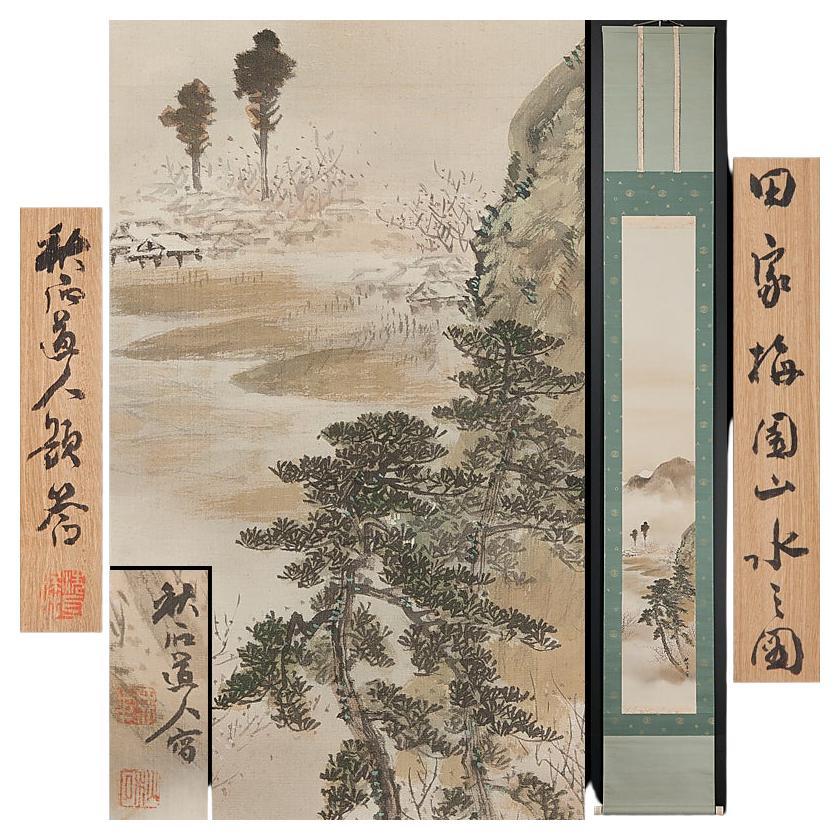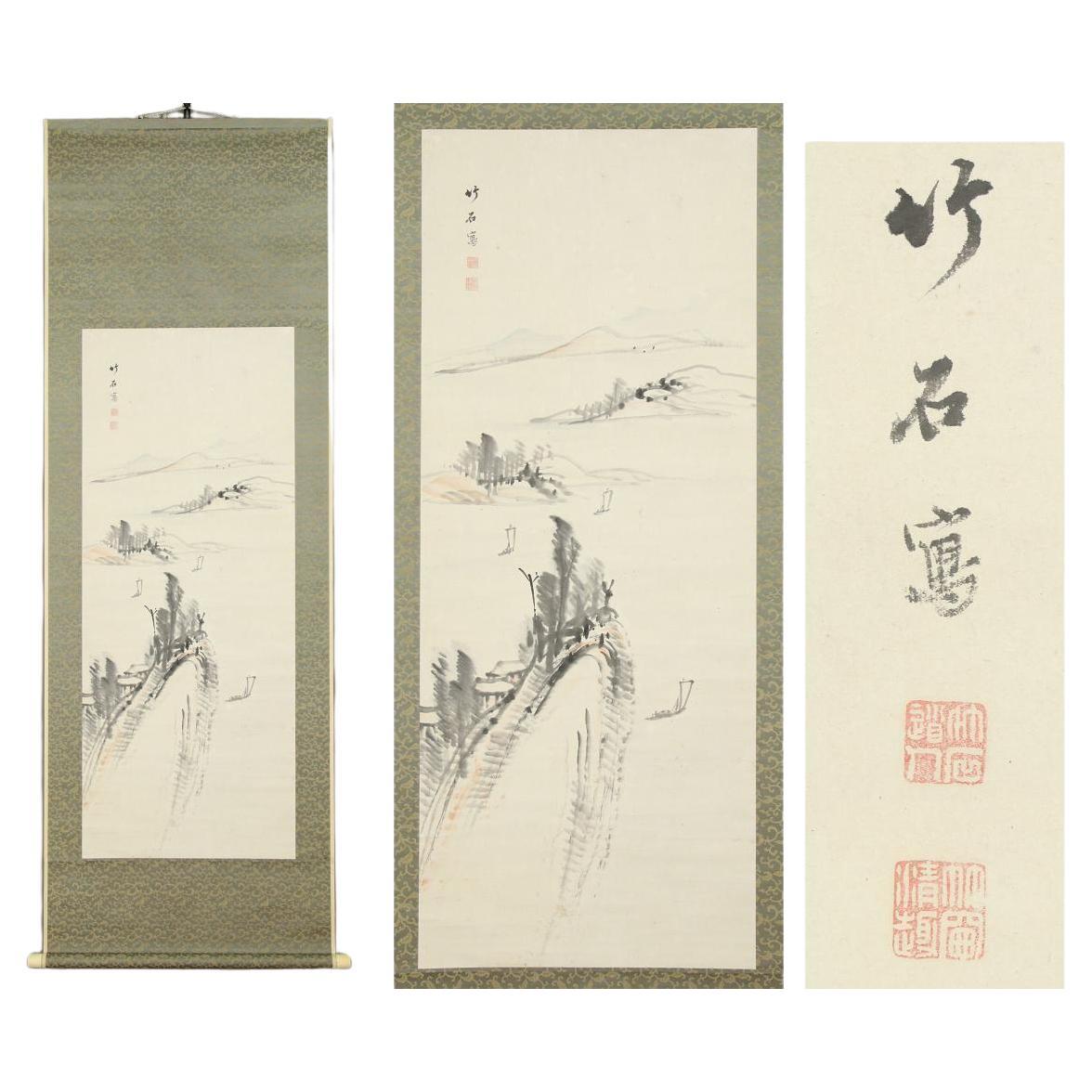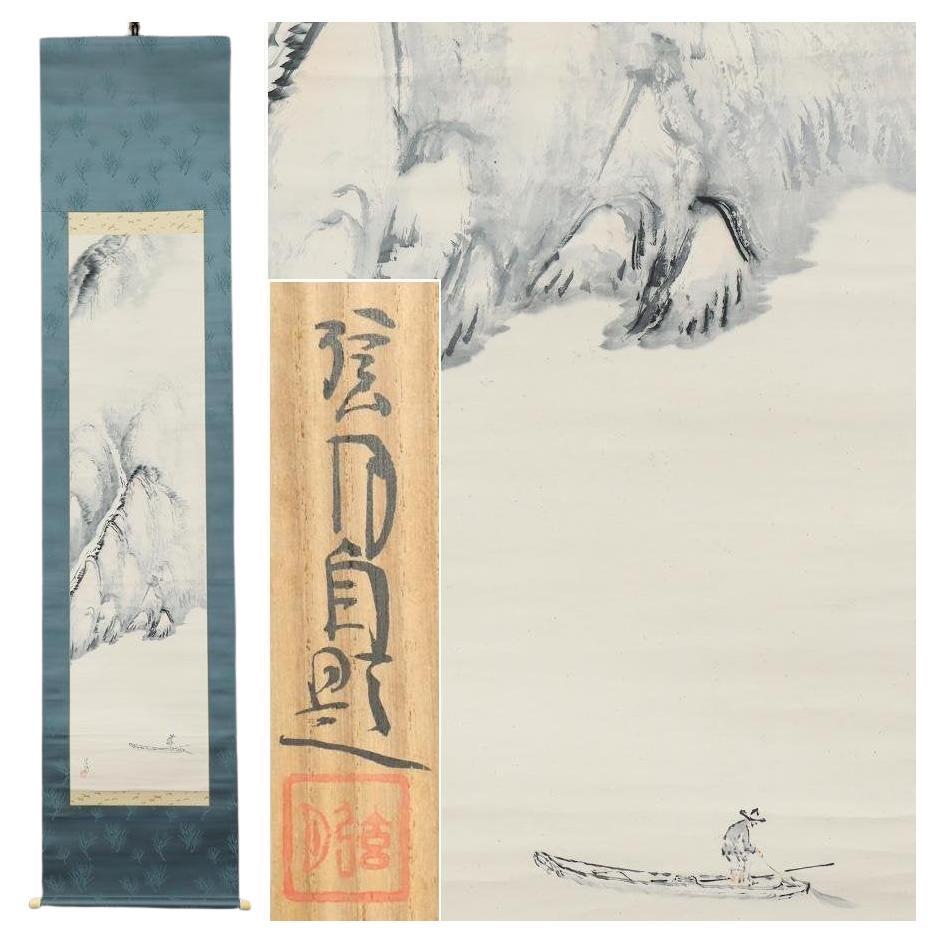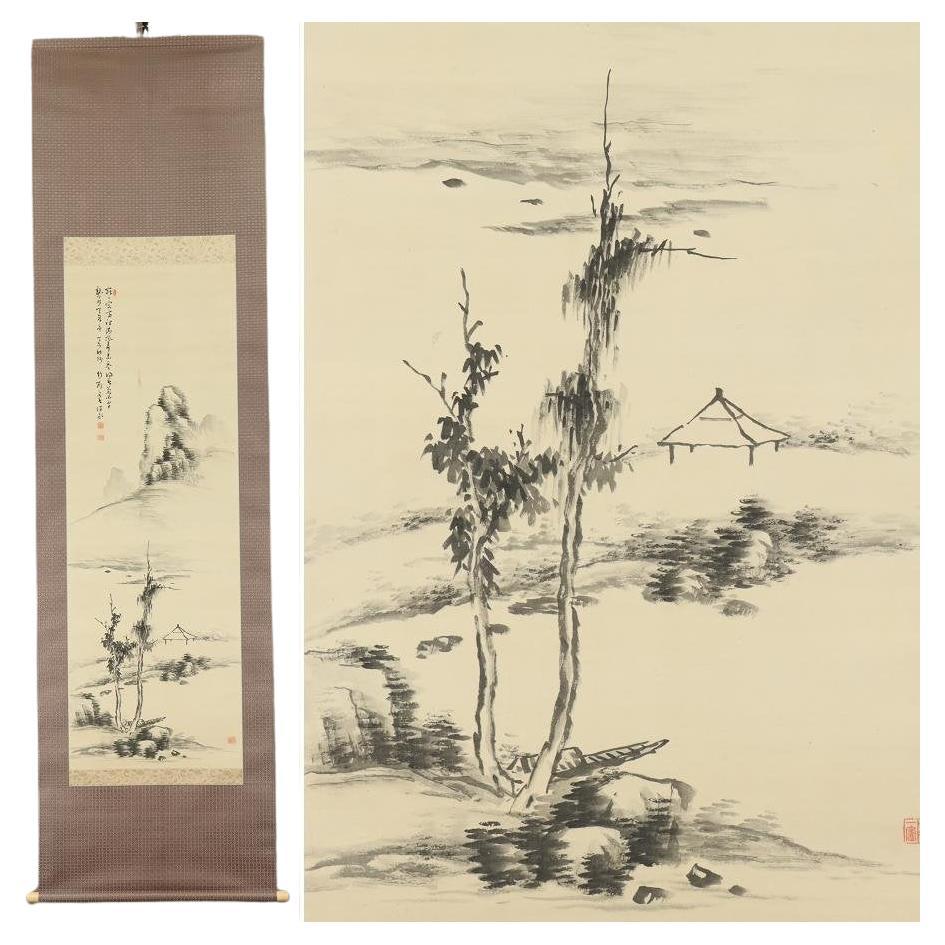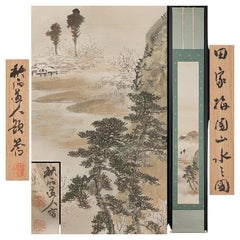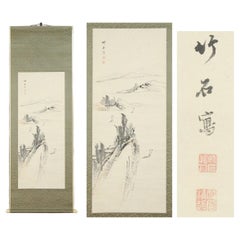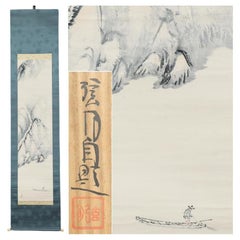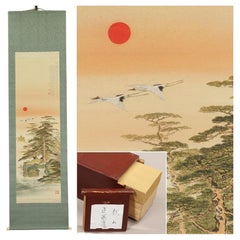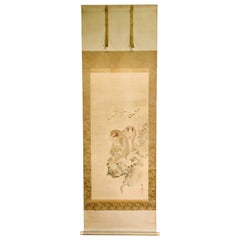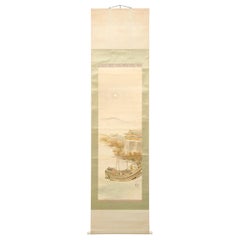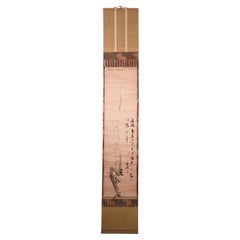Items Similar to Nihonga Japanese Painting 1900 Meiji Scroll Kawai Gyokudo Nanga School Lake Scen
Want more images or videos?
Request additional images or videos from the seller
1 of 7
Nihonga Japanese Painting 1900 Meiji Scroll Kawai Gyokudo Nanga School Lake Scen
$2,299.66
$2,874.5820% Off
£1,704.17
£2,130.2220% Off
€1,920
€2,40020% Off
CA$3,139.47
CA$3,924.3420% Off
A$3,492.54
A$4,365.6720% Off
CHF 1,830.83
CHF 2,288.5420% Off
MX$42,677.93
MX$53,347.4220% Off
NOK 23,313.35
NOK 29,141.6820% Off
SEK 21,946.29
SEK 27,432.8620% Off
DKK 14,618.71
DKK 18,273.3920% Off
Shipping
Retrieving quote...The 1stDibs Promise:
Authenticity Guarantee,
Money-Back Guarantee,
24-Hour Cancellation
About the Item
This painting by Gyokudo Kawa is named "Lakeside Night Return", portraying a serene journey home.
Gyokudo Kawai
(1873-1957)
A Japanese painter from the Meiji to Showa periods, born in Aichi Prefecture. Gyokudo Kawai, also known as Yoshizaburo, developed a unique style blending the Shijo and Kano schools. Notable for winning the first prize at the Tokyo Prefectural Industrial Exhibition in 1908, he served as a Bunten judge and a professor at the Tokyo School of Fine Arts.
Details:
Dimensions:
Axis: Approx. 126.0cm x 66.0cm
Paper: Approx. 30.0cm x 53.0cm
Condition:
In good condition, showcasing Gyokudo Kawai's artistry.
Inscriptions:
Includes inscriptions and details.
Box:
Comes with a protective box.
- Dimensions:Height: 49.61 in (126 cm)Width: 25.99 in (66 cm)Depth: 0.04 in (1 mm)
- Style:Meiji (Of the Period)
- Materials and Techniques:
- Period:
- Date of Manufacture:ca 1900
- Condition:Wear consistent with age and use.
- Seller Location:Amsterdam, NL
- Reference Number:Seller: 1201stDibs: LU4863237230842
About the Seller
5.0
Platinum Seller
Premium sellers with a 4.7+ rating and 24-hour response times
Established in 2015
1stDibs seller since 2019
264 sales on 1stDibs
Typical response time: 2 hours
- ShippingRetrieving quote...Shipping from: Amsterdam, Netherlands
- Return Policy
Authenticity Guarantee
In the unlikely event there’s an issue with an item’s authenticity, contact us within 1 year for a full refund. DetailsMoney-Back Guarantee
If your item is not as described, is damaged in transit, or does not arrive, contact us within 7 days for a full refund. Details24-Hour Cancellation
You have a 24-hour grace period in which to reconsider your purchase, with no questions asked.Vetted Professional Sellers
Our world-class sellers must adhere to strict standards for service and quality, maintaining the integrity of our listings.Price-Match Guarantee
If you find that a seller listed the same item for a lower price elsewhere, we’ll match it.Trusted Global Delivery
Our best-in-class carrier network provides specialized shipping options worldwide, including custom delivery.More From This Seller
View AllJapanese Nihonga Painting 1900 Meiji/Taisho Scroll Shûseki, Okutani Landscape
Located in Amsterdam, Noord Holland
Susheki Okutani "Takaya Plum Garden Landscape"
Silk, Colored, Authentic, Hanging Scroll, , Double Box
size Axis: Height 206.5cm Width 29.3cm
Drawing…Height 126.7cm Width 19.5cm *There may be slight differences in dimensions. Thank you for your understanding.
situation It is in good condition, but please note that there are some light stains.
Please check the image for details.
Thank you for your support.
Biography Akishi Okutani
Japanese painter. Born in Osaka. His name is Tsunejiro. He studied under Kansai Mori. From an early age, he exhibited his works at the Japan Painting Association and the Young People's Painting Association, which was led by Gaho Hashimoto and Gyokusho Kawabata, and won numerous awards. He also opened a private school...
Category
20th Century Taisho Paintings
Materials
Silk
$1,722 Sale Price
20% Off
Japanese Painting 18c Edo Scroll Chikuseki Nagamachi Nihonga Landscape Painting
Located in Amsterdam, Noord Holland
[Authentic Artwork] ◆ Nagamachi Chikuseki ◆ Landscape ◆ Edo Period ◆ Mitsuishi Origin ◆ Kagawa Prefecture ◆ Handwritten ◆ Paperback ◆ Hanging Scroll ◆ k891 ◆ Nagamachi Chikuseki
Explore the artistry of Chikuseki Nagamachi...
Category
Antique 18th Century Edo Paintings
Materials
Silk
$1,818 Sale Price
20% Off
Japanese Painting Taisho / Showa Period Scroll by Yazawa Gengetsu Landscape
Located in Amsterdam, Noord Holland
[Authentic work] ◆ Gengetsu Yazawa ◆ Mountain and Lake Off Day ◆ box ◆ Landscape ◆ Nagano Prefecture ◆ Handwritten ◆ Paperback ◆ Hanging scroll ◆
Gengetsu Yazawa
Art yearbook appr...
Category
Vintage 1930s Taisho Paintings
Materials
Silk
$1,809 Sale Price
20% Off
Japanese Painting Taisho / Showa Period Scroll by Yano Tetsuzan Nanga Landscape
Located in Amsterdam, Noord Holland
[Authentic work] ◆ Tetsuzan Yano ◆ Horai Sekkaku ◆ Landscape ◆ Double box ◆ Ehime Prefecture ◆ Hand-painted ◆ Silk ◆ Hanging scroll ◆
Tetsuzan Yano [Yano Tetsuzan]
Art Yearbook app...
Category
Vintage 1930s Taisho Paintings
Materials
Silk
$2,767 Sale Price
20% Off
Japanese Painting Taisho / Showa Period Scroll by Shuson Kono Nanga Landscape
Located in Amsterdam, Noord Holland
Authentic work ◆ Shuson Kono ◆ Illustrated landscape of the literati ◆ Shared box ◆ Landscape ◆ Ehime Prefecture ◆ Handpainted ◆ Silk ◆ Hanging scrol...
Category
Vintage 1930s Taisho Paintings
Materials
Silk
$2,201 Sale Price
20% Off
Japanese Nihonga Painting 19th Meiji Scroll Tajika Chikuson Landscape Nanga
Located in Amsterdam, Noord Holland
[Authentic Artwork] ◆ Chikuson Tajika ◆ Autumn Landscape ◆ Master: Naoiri Tanomura ◆ Oita Prefecture ◆ Hand-Painted ◆ Silk Mounted ◆ Hanging Scroll ◆
Delve into the artistry of Chik...
Category
Antique 19th Century Edo Paintings
Materials
Silk
$1,147 Sale Price
20% Off
You May Also Like
Japanese Silk Scroll Painting of Moneys Edo Period Mori Tetsuzan
Located in Atlanta, GA
A Japanese mounted vertical hanging scroll painting by Mori Tetsuzan (Japanese, 1775-1841) circa 19th century Edo period. The watercolor and ink on silk ...
Category
Antique 19th Century Japanese Japonisme Paintings and Screens
Materials
Silk, Paper
Japanese Meiji Riverside Scroll Painting, c. 1900
Located in Chicago, IL
Although western painting was initially embraced during Japan’s Meiji period (1868-1912), artists brought on a revival of traditional painting styles as they sought to create a modern Japanese style with roots in the past. This exquisite hanging scroll demonstrates the preference for soft layering of gray tones with judicious use of color. The landscape is rendered in soft ink washes that subtly distinguish between water, mountain, and sky. The scroll painting...
Category
Early 20th Century Japanese Meiji Paintings and Screens
Materials
Paper
Japanese ink on paper painting of Plum Blossoms, Tani Buncho
Located in Point Richmond, CA
Japanese ink on paper painting of Plum Blossoms and Poem, scroll mounting, signature & single seal: Tani Buncho (1763 - 1840). A famous and prol...
Category
Antique 19th Century Japanese Meiji Paintings and Screens
Materials
Paper
Japanese Landscape Painting, Hanging Scroll Painting
Located in Greenwich, CT
Japanese scroll painting of landscape painting depicted village along the riverside in the mountains with fisherman
Ink and color on silk
Overall size...
Category
Antique 19th Century Japanese Paintings and Screens
Materials
Silk
Japanese Silk Scroll by Haruki Nanmei Edo Period
Located in Atlanta, GA
A Japanese hanging silk scroll by late Edo period painter Haruki Nanmei (1795-1878). The gouache painting was in the tradition of Kano school and depicts an old scholar dressed in lo...
Category
Antique 19th Century Japanese Edo Paintings and Screens
Materials
Silk, Paper
Japanese Hanging Scroll, Late 19th Century
Located in New York, NY
A Japanese hanging scroll or Kakejiku, circa 1890, depicting bamboo grass and a rabbit, framed by top and bottom ribbons of brocade silk.
In ...
Category
Antique 1890s Japanese Meiji Paintings
Materials
Silk, Paper
$2,624 Sale Price
20% Off
More Ways To Browse
Japanese Scroll Kano
Kawai Gyokudo
Onyx Clock Antique
Pennsylvania Chests Of Drawers
Shoe Polish Vintage
Skyscraper Model
Soldier Doll
Stamped Tiffany Paris
Swan Brass Italy
Talking Plates
Teak Temple
Toile Jouy
Used Cherry Wood Kitchen Cabinets
Used Traffic Signs
Victorian Dressing Case
Vintage Alessi
Walnut Modern China Cabinets
William And Mary Antiques
